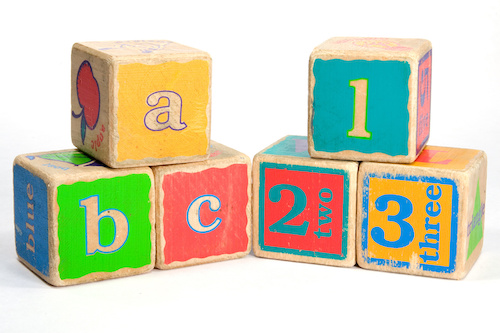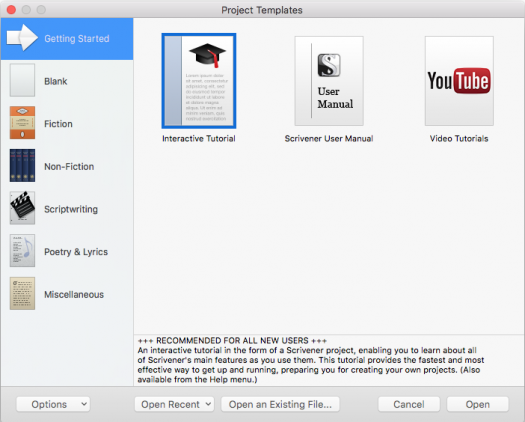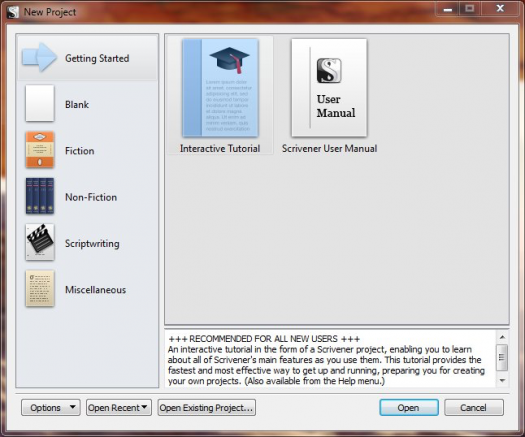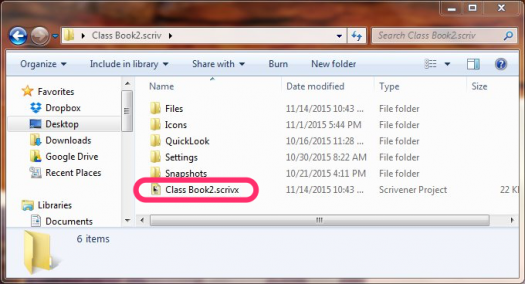Scrivener Fundamentals: What every Scrivener user should know (but probably doesn’t)
By Gwen Hernandez | November 18, 2015 |
 When I started teaching Scrivener courses, I often skipped the basics. I figured everyone knew how to use a computer, therefore they already understood this stuff. I was wrong. There are a few key concepts that many users—new and old—don’t get.
When I started teaching Scrivener courses, I often skipped the basics. I figured everyone knew how to use a computer, therefore they already understood this stuff. I was wrong. There are a few key concepts that many users—new and old—don’t get.
So, it made sense to me that my first instructive post here should cover the fundamentals.
Starting Scrivener
Start Scrivener the way you’d start any other program on your computer. There are several places to look for the Scrivener program:
The desktop, taskbar (PC), Start menu (PC), Program Files folder (PC), Applications folder (Mac), or Dock (Mac).
Another option is to open an existing Scrivener project from your file management system (Finder on a Mac, Windows/File Explorer on a PC). This will launch Scrivener too. (This is true of most files on your computer. If you open the file for which the default program is not already running, the computer launches the relevant software as well.)
When you start Scrivener, you will see one of three things:
1. The New Project window
This window appears the first time you use Scrivener, and anytime you closed all projects before exiting the program last time (see #2). From here, you can either create a new project or open an existing one.
You can also access the New Project window when Scrivener is open by choosing File—>New Project.
2. The last project(s) you viewed
If you close Scrivener without closing your projects first—totally okay to do—it will open those same projects when you start it next time. Pretty cool, huh?
3. Nothing but the menu bar
If you start Scrivener and don’t see the New Project window or an open project, that’s okay. It just means your settings/preferences are set that way. You can still open a project via File—>Open.
You can change your settings to ensure you always see the New Project window when there’s no project open in Scrivener. Here’s how.
Mac: Go to Scrivener—>Preferences—>General, and check the box to Show Template Chooser When There Are No Projects Open.
Windows: Go to Tools—>Options—>General, and check the box to Show Start Panel When There Are No Projects Open.
Working with Scrivener Files
A Scrivener project file has a .scriv extension. On Windows, it displays as a folder with subfolders and files inside (see image in next section). On a Mac, it appears as just a file (the subfiles are hidden).
WARNING (PC users): All those little files need to stay together inside the .scriv folder for your project to work properly. If you ever open the .scrivx file and see the structure of your project but no text—scary, right?—your .scrivx was probably separated from the rest of the group.
Opening an Existing Scrivener Project
There are several ways to open an existing Scrivener project.
Opening From Your Computer’s File System
To open a project directly from Finder or Windows/File Explorer (or your Desktop, etc), double-click the .scriv file. Windows users have to go one step further and double-click the .scrivx file inside, which should have the same name as the .scriv folder, as shown in the image below. (NOTE: It might be called project.scrivx if created on a version prior to 1.9 and not yet updated to the new file format.)
If Scrivener is not yet open, your computer will launch the program.
Opening From Within Scrivener
If Scrivener is already open, you can go to File—>Open to access your drives and find the project you want. File—>Recent Projects provides access to the last few projects you’ve opened.
Opening From the New Project Window
To open a project from the New Project Window (refer to the Starting Scrivener section above), you can click the Open An Existing File (Mac) or Open Existing Project (PC) button. Or, you can click the Open Recent button for a list of recently viewed projects.
Working with Multiple Projects
You can have more than one Scrivener project open at the same time. This is handy for dragging items from one Binder to another (to copy), or when you want to refer to another project or a “series bible” while working on your current manuscript.
Or, if you’re like me, maybe you just like to have all current projects open all the time. ;-)
Simply use either of the first two methods described in the previous section to open an additional project.
Closing Scrivener Projects
When you’re ready to close a project, you have two options.
Close the project, but not Scrivener
To do this, click the Close button on the window (red dot on the Mac, red X in Windows) or go to File—>Close Project. Repeat for each open project, as desired. Next time you open Scrivener the project will not automatically appear.
Close Scrivener and the project
Go to Scrivener—>Quit Scrivener (Mac) or File—>Exit (PC).
If you close Scrivener without closing your open projects first, Scrivener closes the projects—backing up them up first unless you’ve turned off automatic backups, tsk, tsk—and then closes the program. Next time you open Scrivener, all of the projects that were open will reappear.
Moving, Copying, Renaming, and Deleting Projects
If you want to move, copy, rename, or delete a Scrivener project, you can do so from Finder (Mac) or Windows/File Explorer (PC), just as you would with a photo, a Word document, or any other file. I suggest closing the project first.
REMINDER: Windows users, remember to always work with the .scriv folder, not the .scrivx file inside it.
If you need more help working with files on your computer, check out one of the links below.
Mac (Intro to Finder and OS X Overview) | Windows 10 | Windows 8 | Windows 7 (Video or Tutorial)
Okay, hit me with your questions, or with topics you’d like to see in future posts. Happy Scrivening!
[coffee]












Thanks for this post. I use Scrivener but it is still somewhat of a mystery to me. I may come back to you with some questions! I look forward to more in this series.
Ask away, Carol! :-)
I thought I recognized your name, Gwen. I have your blog’s screenwriting post up on a tab, probably need to send it to Kindle for whenever reading :)
But I’ve also bookmarked your post and this one.
I started the tutorial recently, and even used Scrivener to sort out and order the first dozen or so chapters on a book I’m working on.
I’ve a feeling in time it’ll become my go to, vs LibreOffice right now.
Thanks so much for the continuing info :)
Felipe: I’m glad the screenwriting post has been helpful. Good luck with the book!
LOL. Pretty obvious stuff, right? It’s funny how I sometimes need to be reminded how to tie my shoes, though.
I don’t yet use Scrivener. I’ve jury rigged something like it, which is just reinventing the wheel. Why do I do that? Stubborn, I guess.
This post is the first of a series? Awesome. I’m looking forward to learning what more the program can do. Doubtless more than I can do on my own.
Benjamin: You sound like the perfect candidate for Scrivener. You might give the free 30-use trial a chance and see what you think. If you decide you like it and you’re participating in NaNoWriMo, there’s a 20% discount (50% if you “win”).
This is actually my second post this year on Scrivener, but the first “how to” guide. If you’re wondering what I like so much about the software, check out my September article on my favorite features: https://staging-writerunboxed.kinsta.cloud/2015/09/16/9-or-more-things-i-love-about-scrivener/.
I’ll be back in January–and several other times next year–with more. Thanks!
I’m so happy that WU is doing these Scrivener tutorials! I can’t begin to say how much I enjoy using Scrivener, but I still have lots to learn. Look forward to you unlocking more secrets, Gwen!
Thanks, Carmel!
Gwen, I have Scrivener for Dummies and use it a lot. Right now, I’m trying to master compiling. When I work in Scriv I prefer to set my margins all the way out, but when I compile, the text runs off the page in my Word doc. Where in the compile settings do I set margins, especially since I may compile the same project to different projects with completely different page sizes. I thought I was doing it right, but it never seems to work. Even my font doesn’t compile correctly. Thanks!
Debra: The first thing I’d check is Page Settings in Compile to make sure you’re using the correct paper size. That’s also where you can set the margins.
Which compile preset are you using (from the Format As drop-down menu at the top of the Compile window)? Mac or PC?
The paper size options are very limited: A4, Letter, Custom. If I select custom there is no way for me to set what those custom parameters are. I work on a PC and usually choose the option I need in the Format as menu, i.e. ebook. But once I start to make any kind of change to the presets, that Format As field automatically changes to Custom. I plan to work through each chapter on compiling with a hands-on approach, reading and then doing. Thanks for your help.
Debra: If you select Custom under Paper Size, it should give you a small window where you can adjust width and height. If not, you might consider restarting Scrivener or even your computer.
The reason the Format As changes to Custom once you start making changes is so that you know you’ve adjusted things and are no longer working with the preset exactly as it was defined.
Once you have things set up and working the way you want them, you can save your own preset for future use. HTH!
Thanks. I’ll certainly give all this a try.
Would love suggestions when work with exitor requires me (or choose to) compile – make changes on document when out of Scrivener – reload into Scrivener.
Very useful post!
That one can get tricky, Tom. If the editor is using Track Changes, the document will not import nicely back into Scrivener unless you accept/reject all changes first and import the final version. If you have to show all of your work for the editor in Word–with Track Changes and comments–then you might be stuck in Word for edits.
NOTE: Comments import just fine, and convert to Scrivener comments.
For my fiction, I like to view the editor’s suggestions in Word (either on my iPad or half of my screen) and make the changes in the Scrivener project. When I wrote Scrivener For Dummies, I was stuck in Word after the first draft. I imported each subsequent version into Scrivener so I’d have a searchable record, and for the ability to keep using it as a project management tool.
Here’s a post where I went into more detail on my revision process: https://gwenhernandez.com/2014/02/19/revisions-in-scrivener/. Thanks!
Thank you for the assist and the link.
Scrivener has a challenging learning curve for me. I own “Scrivener for Dummies” but still am spending a fair amount of time becoming functional with Scrivener. I’m anticipating that, in the long run, the time spent in achieving competence will pay big dividends (currently writing book #2 in a series and anticipate several more).
Again – thank you!
Sure thing, Tom. Good luck with the series!
I have heard good things about the Interactive Tutorial under the Help menu.
I plan to try it after I finish this project, which I’d like to finish before the trial runs out. I know I’ll feel that bizarre buyer’s remorse that comes even when you get objectively good value for your money, and I won’t be productive for a week.
Michael: The interactive tutorial is a great place to start, and it was recently revamped. Good luck with your current project!
I’m a Scrivener newbie, and I agree with the expert – the interactive tutorial is great. Drop everything else and spend a little time with it, if nothing else to get familiar with Scrivener’s lingo (Inspector? Scrivenings Mode?)
Seeing as this is nano time, I’m using dropbox to save my files, and shifting back and forth between two computers. I’ve been using Scrivener since the PC beta version first came out. For the first time ever,this morning I had the problem you described, of seeing only structure and no text. (Scary doesn’t even begin to describe it!). I’ll go back and make sure I’ve got the scriv file, instead of the scrivx file. Have I done any damage by opening the wrong file?
lauriegienapp: Opening the SCRIVX without its other files doesn’t harm anything. If you made any changes to the structure file while it was open, Scrivener might need to re-index or something once you reunite them, but otherwise, everything should be fine.
I have read your Scrivener for Dummies book and return to it often. Even though I think I know how to do a procedure or use a tool I find you often have suggestions on how to do it better. I’m looking forward to reading all your posts here and picking up lots of tips.
fkhill0647: Glad to hear it. Thanks!!
I’m one of those newbies that needs basic help. Will I be able to work Scrivener on both my desktop PC and my laptop? How would I be able to do this? Thanks for your help! It looks like I need to get your book! I don’t have Scrivener yet, but I’m considering it.
Rebecca: You can work with Scrivener on multiple computers. In fact, the Scrivener license is good for up to five computers within your household (as long as they’re the same operating system, e.g. all Windows). Probably the easiest way to work with a project on two computers is to use a cloud service like Dropbox. A flash drive would also work.
There’s a great article on how to do this, and some considerations here: https://scrivener.tenderapp.com/help/kb/cloud-syncing/using-scrivener-with-cloud-sync-services.
Before you commit to Scrivener, you can check it out with a 30-use free trial. It’s the full version of the program, but will expire after 30 opens if you don’t pay and input the registration code. I hope you like it!
Thanks so much! I do have Dropbox. :)
This was a question I hadn’t even thought of reading this post — but I have wondered about it when my son is tying up the laptop I usually work on. Now I can make sure I’m ready to swap laptops. Thanks for showing us the way.
I bought Scrivener on Windows and have used it very little. But I was recently gifted a Mac, and am using Scrivener’s NaNo trial to write this year’s NaNo and I just ‘get it’ now. It has been a lifesaver for linking pages and creating my first draft and I really love that I can save to the cloud, to google drive and to my USB as well as my docs. I haven’t lost one word this year, and that is REALLY taking a ton of stress off the Nano this year. I love it!
Thank you for posting these things. Sometimes people don’t realize the little things about new tools and it can be frustrating. I know for me it was. :)
Sure thing, AlwaysReiding (clever name). I’m glad Scrivener finally clicked for you. Sometimes it takes a few looks, and maybe the realization that you have a need that other software can’t address. I hope you rock NaNo!
Thanks for a great post. When I printed my first draft, I found some scenes/documents were empty…have you any idea how I’ve lost them? Is it to do with what you mention above, but all I’ve ever done is closed down scrivener and accepted the automatic saving, so why would some scenes save and some not? Thanks!
Abigail: There are a couple places to check for that. First, is the text in those documents when you view it in the Editor? If so, then it’s not lost, just not printing.
When you’re in Compile, check on the Contents tab to ensure that all documents have a checkmark in the Include column.
Another cause could be that your documents aren’t in the Draft/Manuscript folder. If not, you won’t even see them on the Contents tab.
If neither of those is the culprit, you can also check the table in the Formatting tab to make sure the checkbox under the Text column is selected for all document types. Let me know if any of that helps!
I’ve not had chance to check it out yet, though your suggestions sound very plausible! What I have done is order your book – thank you!
Thanks, Abigail! I hope you find it helpful. Feel free to follow up with me here (or on my site) if you get stuck. :-)